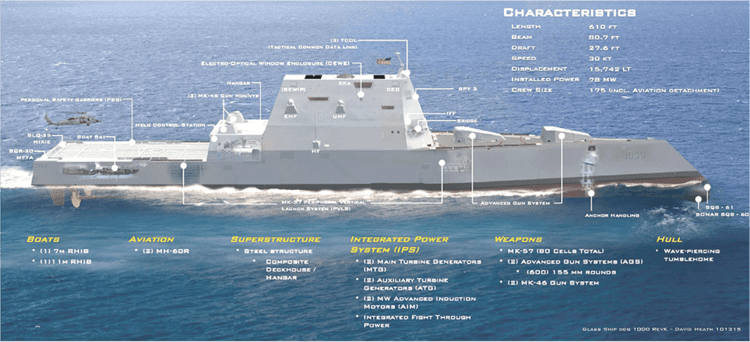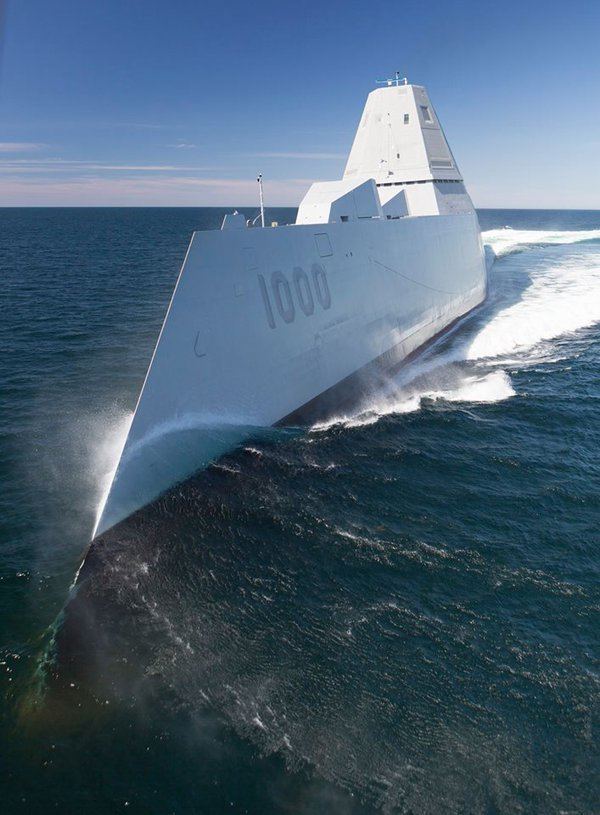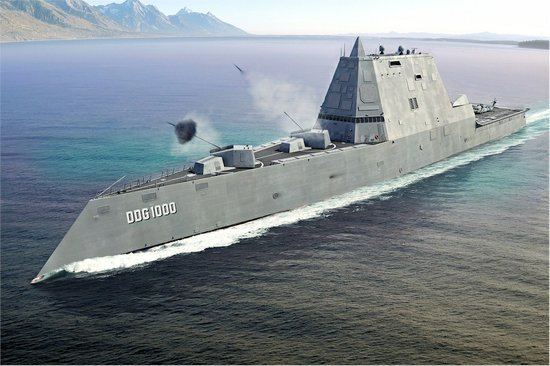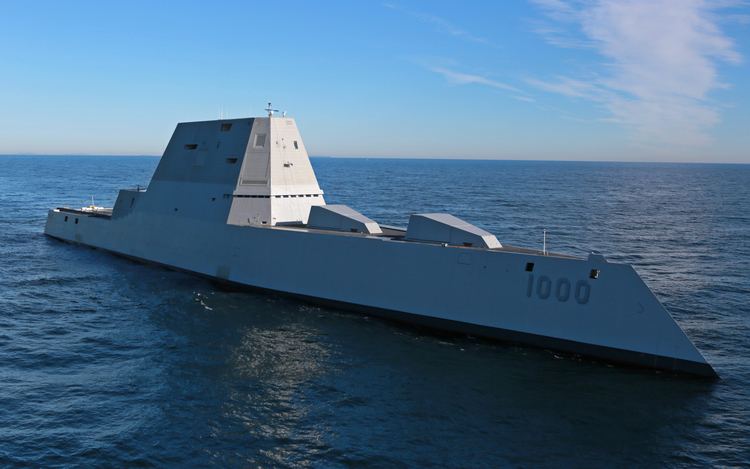Name Zumwalt Awarded 14 February 2008 Christened 12 April 2014 Construction started 2008 Builder Bath Iron Works | Laid down 17 November 2011 Length 183 m Launched 28 October 2013 | |
 | ||
Cost ≈$3.5 billion to 4.4 billion | ||
USS Zumwalt (DDG-1000) is a guided missile destroyer of the United States Navy. She is the lead ship of the Zumwalt class and the first ship to be named for Admiral Elmo Zumwalt. Zumwalt has stealth capabilities, having a radar cross-section akin to a fishing boat despite her large size. On 7 December 2015, Zumwalt began her sea trial preparatory to joining the Pacific Fleet. The ship was commissioned in Baltimore on 15 October 2016. She is homeported in San Diego, California.
Contents
- Uss zumwalt ddg 1000 time lapse and sea trial
- Namesake
- Role
- Construction
- Sea trials
- Post commissioning
- References

Uss zumwalt ddg 1000 time lapse and sea trial
Namesake

Zumwalt is named after Elmo Russell Zumwalt, Jr., who was an American naval officer and the youngest man to serve as the Chief of Naval Operations. As an admiral and later the 19th Chief of Naval Operations, Zumwalt played a major role in U.S. military history, especially during the Vietnam War. A highly decorated war veteran, Zumwalt reformed the US Navy's personnel policies in an effort to improve enlisted life and ease racial tensions. After he retired from a 32-year naval career, he launched an unsuccessful campaign for the United States Senate.

The hull classification symbol for Zumwalt is DDG-1000, which departs from the guided missile destroyer numbering sequence that goes up to DDG-126, which as of 2016, is Louis H. Wilson, Jr., the latest of the named Arleigh Burke-class destroyers. Zumwalt continues the previous "gun destroyer" sequence left off with 1983, DD-997, the last of the Spruance class, Hayler. With the production run of the Zumwalt class limited to three units, plans are underway for a third "flight" of Arleigh Burke-class destroyers.
Role

The Zumwalt class was designed with multimission capability. Unlike previous destroyer classes, designed primarily for deep-water combat, the Zumwalt class was primarily designed to support ground forces in land attacks, in addition to the usual destroyer missions of anti-air, anti-surface, and undersea warfare. The Long Range Land Attack Projectile (LRLAP), one of a range of land attack and ballistic projectiles with a range of up to 100 nautical miles (190 km; 120 mi) fired from a gun, is a key component.
Construction

Many of the ship's features were originally developed under the DD21 program ("21st Century Destroyer"). In 2001, Congress cut the DD-21 program by half as part of the SC21 program. To save it, the acquisition program was renamed as DD(X) and heavily reworked. The initial funding allocation for DDG-1000 was included in the National Defense Authorization Act of 2007.

The $1.4 billion contract was awarded to Bath Iron Works in Bath, Maine. Full rate production officially began on 11 February 2009.
In July 2008, the construction timetable was for General Dynamics to deliver the ship in April 2013, with March 2015, as the target for Zumwalt to meet her initial operating capability. However, by 2012 the planned completion and delivery of the vessel had slipped to the 2014 fiscal year.
The first section of the ship was laid down on the slipway at Bath Iron Works on 17 November 2011. By this point, fabrication of the ship was over 60% complete. The naming ceremony was planned for 19 October 2013, but was canceled due to the United States federal government shutdown of 2013.
The vessel was launched from her shipyard in Bath, Maine on 29 October 2013.
Sea-trials
In January 2014, Zumwalt began to prepare for heavy weather trials, to see how the ship and her instrumentation react to high winds, stormy seas, and adverse weather conditions. The ship's new wave-piercing inverted bow and tumblehome hull configuration reduce her radar cross-section. Tests involved lateral and vertical accelerations and pitch and roll. Later tests included fuel on-loading, data center tests, propulsion events, X-band radar evaluations, and mission systems activation to finalize integration of electronics. These all culminated in builders' trials and acceptance trials, with delivery for US Navy tests in late 2014, and with initial operating capability (IOC) to be reached by 2016.
Zumwalt's commanding officer is Captain James A. Kirk. Kirk attracted some media attention when he was first named the captain, due to the similarity of his name to that of the Star Trek television character Captain James T. Kirk, played by William Shatner. Shatner wrote a letter of support to Zumwalt's crew in April 2014.
On 7 December 2015, the ship departed Bath Iron Works for sea trials to allow the Navy and contractors to operate the vessel under rigorous conditions to determine whether Zumwalt is ready to join the fleet as an actively commissioned warship.
On 12 December 2015, during sea trials, Zumwalt responded to a US Coast Guard call for assistance for a fishing boat captain who was experiencing a medical emergency 40 nautical miles (74 km) from Portland, Maine. Due to deck conditions, the Coast Guard helicopter was unable to hoist the patient from the fishing boat, so the Zumwalt's crew transferred him to the destroyer using an 11-meter rigid-hulled inflatable boat (RHIB), from which he was transported to shore by the Coast Guard helicopter and then to a hospital.
The US Navy accepted delivery of Zumwalt on 20 May 2016. In September 2016, it was reported that the vessel needed repairs after the detection of a seawater leak in the ship's auxiliary motor drive oil system. The US Navy commissioned Zumwalt on 15 October 2016, in Baltimore during Fleet Week.
Post-commissioning
On 21 November 2016, Zumwalt lost propulsion in its port shaft while passing through the Panama Canal from the Atlantic to the Pacific Ocean en route to its homeport in San Diego. Sea water had intruded in two of the four bearings that connect Zumwalt's port and starboard Advanced Induction Motors to its drive shafts. Both drive shafts failed and Zumwalt hit the lock walls in the canal, causing minor cosmetic damage. Zumwalt's passage through the Panama Canal had to be completed with tugboats. Zumwalt underwent repairs at Vasco Núñez de Balboa Naval Base (the site of former US Naval Station Rodman) before continuing on to Naval Station San Diego. Upon arrival in San Diego, the leak was revealed to be through the lubrication cooling system, though the cause remains unknown.
